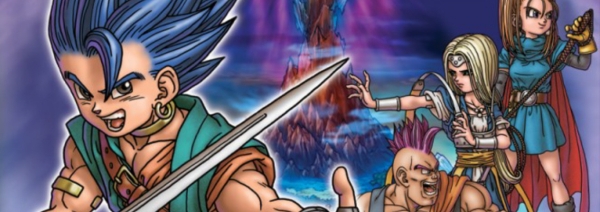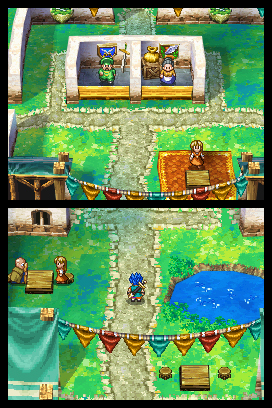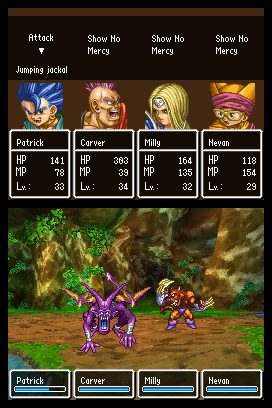
With a little help from Nintendo, Square Enix has resurrected a fallen soldier from a popular franchise, enlisting the help of the DS along the way. Dragon Quest VI: Realms of Revelation is a breath of fresh air from their old, musty library; a remake that is both nostalgic and refreshing, incorporating new elements of gameplay, and boasting a visual makeover for the American premiere. Though it’s been 15 years since its initial release, Realms of Revelation plays like it was made yesterday.
Platforms: DS
Publisher: Nintendo
Developer: Square Enix
Genre: Old-School/New-School RPG
Release Date: February 14, 2011
ESRB Rating: Teen
In a dream world, localization is a process that every video game is put through at one point or another in its life span. Unfortunately, in the imperfect real world, the titles that do get localized can take years – or in this case, a decade and a half – before they ever see the light of day in another country. For Dragon Quest VI: Realms of Revelation, that process took 15 long years, after its debut on the Super Famicom (Super NES) in Japan at the end of 1995. At last, America has received a fully and authentically translated version, quenching the fans’ thirst for more role-playing goodness.
As you’ll quickly learn upon starting the game, it utilizes “real world” and “dream world” settings. The story opens with the typical Dragon Quest hero – aptly named “Hero” – and three other characters attempting to fight Murdaw, the Demon King. Murdaw successfully turns each party member to stone, and the hero then wakes up in his hometown. This is where the game actually begins. The hero is first asked to run a few tedious errands, but is quickly made aware of his importance regarding the fate of the two separated worlds. Through various events, the hero recruits some strong – and not-so-strong – allies to aid him on his adventure.
The hero and his allies all make use of the vocations system, previously present in Dragon Quest III. The vocations available to the party start out similarly, but later vary based on each character’s vocation mastery. For example, a character may only take up a Sage vocation if they have first mastered both the Priest and Mage vocations. There are also character-specific vocations, such as the hero’s “Hero” vocation. The same is true for the Dragon vocation, although there are obtainable items that allow other party members to be trained with Dragon skills. Vocations are automatically leveled up after fighting a prerequisite amount of battles, and can be changed once the player reaches Alltrades Abbey near the beginning of the game.
Dragon Quest VI really takes the world exploration aspect to the next level, as far as Nintendo DS (or Super Famicom) games are concerned. Not only do the dream world and real world each offer you a map, the hero and his allies can use a magic spell to switch worlds and teleport the team to any previously visited areas throughout. Each of the two worlds offer transportation ranging from the standard to the extraordinary – from sailing ships, to flying horses, to flying queen-size beds around the world map. Last I knew, transportation wasn’t this awesome in other games. Furthermore, the game’s end pulls the hero and his comrades through at least two additional areas, including the ability to submerge the team’s sailing ship. Each of these areas is complete with a full map and detailed locations. That’s a lot of game for your buck.
 Overwhelmingly detailed villages, castles, dungeons, and secret hideouts are spread across the game’s giant world. Aside from the standard story-related locations, a bunch of obscurely hidden locales contain some pretty rare items and gear to boot. I’ll admit it, I did utilize a guide, and some of these locations would have been nearly impossible to discover without it. Even if you’re a completionist, you might want to use one, as the items you receive for discovering some of these locations are well worth it. For those of you who aren’t as obsessed with finding everything, there’s still plenty to find in plain sight. For example, the game’s “Best-Dressed Contest” and “Slimopolis” can result in some pretty sweet loot!
Overwhelmingly detailed villages, castles, dungeons, and secret hideouts are spread across the game’s giant world. Aside from the standard story-related locations, a bunch of obscurely hidden locales contain some pretty rare items and gear to boot. I’ll admit it, I did utilize a guide, and some of these locations would have been nearly impossible to discover without it. Even if you’re a completionist, you might want to use one, as the items you receive for discovering some of these locations are well worth it. For those of you who aren’t as obsessed with finding everything, there’s still plenty to find in plain sight. For example, the game’s “Best-Dressed Contest” and “Slimopolis” can result in some pretty sweet loot!
The Best-Dressed Contest encourages players to equip the most stylish clothing, armor, and accessories to their party-goers, who then compete against a few NPCs in a fashion contest. Yes, you will actually get to bring your competitor down the catwalk and back, with cat calls and all. Different rankings in the contest are open to different genders, and some rounds warrant “Monsters Only” entrants. Though I’m not the most fashionable cat on the block, I managed to rise through a few ranks myself – enough to at least get the flying rug required in the latter part of the game. Completion of the Best-Dressed Contest allows your team to coax the fashionable King Slime into joining your party.
The Slimopolis is a different entity altogether; those familiar with the Pokémon Battle Frontier will notice a similarity between the two. The Slimopolis has a catch, however: the only monsters that are allowed to participate must be of a slime type. Slime Knights, Mottled Slimes, and King Slimes are among potential competitors. The Slimopolis pits the slime of your choice against competing teams of monsters, as you move from the novice tiers to advanced tiers. Within each tier, slimes fight automatically as the player watches. Also, competitors may only heal themselves during battle, making this arena-style fighting rink to be a bit of a challenge. Like the Best-Dressed Contest, this area also rewards a diligent slimer with some decent prizes.
Aside from the previous two areas, “Slippin’ Slime” machines are located inside most of the game’s inns. Interestingly, this is the only game mechanic that requires the use of the DS’ stylus. Slippin’ Slime is a Dragon Quest variant on Curling, where players must use the stylus to steer their slippery, slimey friend through several courses, avoiding any obstacles, and collecting speed boosts, with the final goal being to stop directly on each course’s target for maximum points. Unfortunately, points are the only incentive for playing this mini-game. I was hoping for something cooler.
Now that anything new to the series is aside, it’s time to address the expected Dragon Quest formalities. The story is great; I don’t want to ruin any exciting plot elements with spoilers, but I will say this: Dragon Quest VI’s story is said to have inspired later games such as Chrono Cross and Final Fantasy X. Several other problems that I noticed in Dragon Quest IV had also been fixed, especially many of the translation problems. For the record, I understand that Dragon Quest games strive to give their townspeople a more accurate depiction through use of varied dialects, but once I reached the town of Lassez Faire, reading the text became a chore.
 As far as battling is concerned, the combat itself is the same as the combat in Dragon Quest IV and V. It occurred to me that the party’s AI got a bit smarter, however; their attacks no longer focus on random enemies. The AI seems to have a bit of logic regarding enemies’ remaining health, as party members allocate their damage relational to the enemies’ remaining HP. For example, if an enemy is lingering there with 5 HP, the weakest party member will attack and kill that enemy rather than adding damage to an enemy with more remaining HP. Similarly, a strong party member won’t waste their devastating attack on the crippled enemy. Instead, they will sink their teeth into a new enemy while your melee-challenged casters beat the weakened enemy into the ground.
As far as battling is concerned, the combat itself is the same as the combat in Dragon Quest IV and V. It occurred to me that the party’s AI got a bit smarter, however; their attacks no longer focus on random enemies. The AI seems to have a bit of logic regarding enemies’ remaining health, as party members allocate their damage relational to the enemies’ remaining HP. For example, if an enemy is lingering there with 5 HP, the weakest party member will attack and kill that enemy rather than adding damage to an enemy with more remaining HP. Similarly, a strong party member won’t waste their devastating attack on the crippled enemy. Instead, they will sink their teeth into a new enemy while your melee-challenged casters beat the weakened enemy into the ground.
Dragon Quest VI’s revival is a return to the more traditional RPG, in a time when the RPG’s roots seem to have withered among the mainstream. Unlike many older RPGs though, Realms doesn’t come off as a grindfest. Leveling throughout the natural course of the game generally syncs up with the bosses and enemies throughout. Only towards the end does the party really need to buckle down and prepare for the final boss, but the practice of perfecting vocations and topping off party members’ HP isn’t a very grueling one.
Realms of Revelation triggers fond memories of exploring sprite-laden maps throughout days of youth, and hitting the “A” button enough times to wipe out enemies, but always stopping to check how much experience the party received. For that, I commend the efforts of the development team in their accurate depiction of the original games, while updating graphics to the style of Dragon Warrior VII. Dragon Quest VI is the poster child for the Zenithian Trilogy’s success through resurrection – a feat that would benefit many other classic RPGs.

Review Disclosure: A retail copy of Dragon Quest VI: Realms of Revelation was purchased by Warp Zoned for the purposes of this review.







